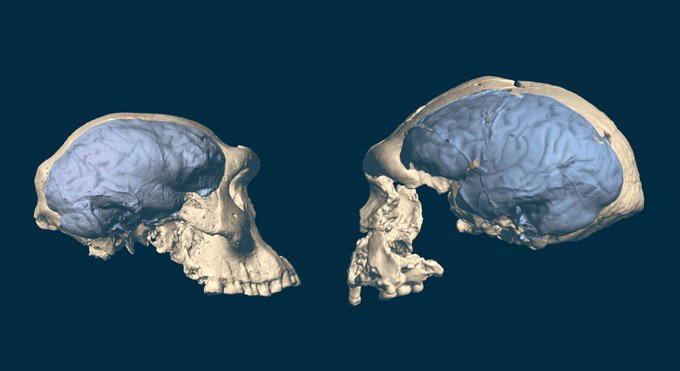paleoanthropologyのTwitterイラスト検索結果。 121 件中 3ページ目
The distal femur of an early #hominin like Australopithecus africanus is among the most humanlike parts of their anatomy. The angulation between the femoral shaft and condyles reflects habitual bipedal gait. #paleoanthropology
The #hominin skeleton from Saint-Césaire, France is one of the last known Neandertals and lived some 42,000-40,000 years ago. The individual suffered but survived, at least for several weeks, a sharp force injury to the head. #paleoanthropology #FossilFriday
Australopithecus anamensis is the earliest known #hominin of its genus. Its diet seems to have concentrated on woodland foods more than the later Au. afarensis or Au. africanus, within a habitat with mixed trees and C4 grasses. #paleoanthropology
Sangiran 2 is the earliest #hominin fossil with endocranial hyperostosis, an abnormal growth of bone on the internal skull surface. This is relatively common today in women over age 65, but very rare in men. The causes of the condition remain unclear. #paleoanthropology
In #paleoanthropology, we try to make careful use of #hominin fossil evidence that may not be beautifully complete but preserves valuable evidence about extinct species. DH4 is one of my favorite fossils, revealing the interaction of skull size and musculature in #Homonaledi
The archaeological record of Flores shows that Homo floresiensis must have been a highly competent stone tool maker and user. The tools left by this #hominin show that large brains and humanlike wrists are not essential to technology #paleoanthropology #FossilFriday
The fossil #hominin remains from Zhoukoudian were fragmented and damaged, with more than 50 individuals mostly represented by one or two fragments or teeth each. The damage may have been made by the extinct cave hyena, Pachycrocuta brevirostris. #paleoanthropology
The occlusal surface of the molars of Paranthropus boisei is three to four times larger than that found in today's humans. The premolars of this #hominin are enormously expanded. But the canine and incisor teeth are human-sized or smaller. #paleoanthropology
When Robert Broom began to find #hominin fossils at Sterkfontein in 1936, the record quickly grew to encompass several individuals. The growing evidence at last brushed back anatomists who had maintained the Taung fossil must be a recent ape. #paleoanthropology
New Research Explores Origins of Structurally Modern Human Brain
https://t.co/6aTJH9aJsX
#paleoanthropology #anthropology #science
A hint of the social behavior of early Homo erectus comes from the earliest known #hominin to survive with near total loss of teeth, 1.8 million years ago. Some wild primates also survive years with little functional dentition. #paleoanthropology #FossilFriday
Paranthropus was a biped like today's humans, but may have used its legs a little differently. Some researchers think the species was climbing more, others point to the dynamics of a relatively wide pelvis in this #hominin. #paleoanthropology #sciart
The femoral morphology of #Homonaledi represents a human pattern of walking and running with a relatively wider pelvis. The proximal femur evolved to solve this functional equation. #hominin #paleoanthropology
The Mojokerto #hominin skull is one of the most important clues about brain size development in Homo erectus. At less than 4 years old, its brain was already larger than many adults known for the species. #paleoanthropology
New @StatedClearly upload: DNA Evidence that Humans and Chimps Share A Common Ancestor.
#evolutionsoup #evolution #paleontology #paleoanthropology #science
👉🏻👉🏽https://t.co/g73aDPhVDi
The discovery of the MLD 18 #hominin mandible in 1953 followed the sorting and movement of more than 5000 tons of miners' dump material. The fossil comes from one of the older adult individuals known for Australopithecus africanus. #paleoanthropology
The three bones of the Swanscombe #hominin skull were found across 20 years within a gravel layer in the course of the ancient Thames River. The skull belonged to an early relative of Neandertals. #paleoanthropology #sciart
The La Quina 18 individual is one of the most complete skulls of a Neandertal child. Impressed with the Mousterian stone tools there, Léon Henri-Martin bought the site and excavated there for thirty years. #paleoanthropology
In 2002, a travertine quarry near Kocabaş, Turkey, sliced through a Homo erectus skull. Only one 35-mm segment was identified. The rest of this 1.4-million-year-old #hominin skull might possibly be tiled into someone's floor. #paleoanthropology
Some of the most significant #hominin fossil collections are those that represent at least some of the anatomy of several individuals. Most scientists interpret the fossils from Ngandong, Indonesia, as Homo erectus individuals just before 100,000 years ago. #paleoanthropology






















